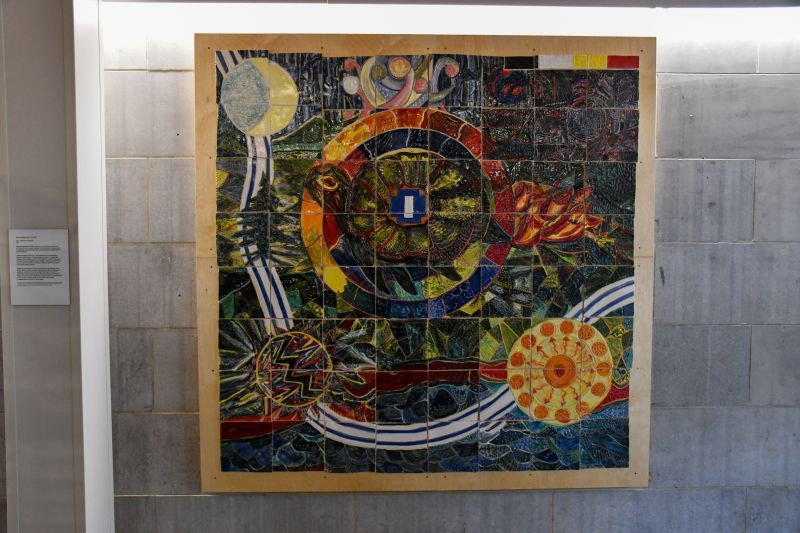
Indigenous mural creates welcoming space for students
Always a hub of activity, the lobby in Humphrey Hall has a new addition, a mural that represents a space of sharing and mutual respect between the Anishinaabe, Mississaugas of the Ojibways, and Haudenosaunee.
Created by artists Georgina Riel and Andy Berg, Gdoo-Naagininaa: Our Dish was unveiled Friday afternoon. The project is part of the Department of Psychology response to the Calls to Action outlined by the Truth and Reconciliation Commission of Canada by increasing the visibility of Indigenous art and culture and recognizing Indigenous territory in spaces across the Queen’s University campus.
“It’s a beautiful, creative, and emotional piece,” says Psychology Department Head Kate Harkness. “It’s a very important moment that we can share as a Department. It provides faculty, staff, and students with the opportunity to take time to reflect on our ancestors who paved the way for us to be here today.”
Weaving through the mural is the relationship and responsibility between nations shown by the Two Row Wampum, an agreement between the Europeans and the First Peoples to co-exist in peace and harmony.
“One thing we talked about during this process was connecting with truth and reconciliation, in particular Action 83 (calling upon the Canada Council for the Arts to establish, as a funding priority, a strategy for Indigenous and non-Indigenous artists to undertake collaborative projects and produce works that contribute to the reconciliation process),” says Riel. “When the call went out from the Department of Psychology, we talked at great length about what this could look like and what forms of media we could use to express how we feel about art and mental health.”
The aim of this project was to create a welcoming space for Indigenous peoples in the Department of Psychology and to help promote awareness around historical/contemporary issues relevant to Indigenous peoples and psychology/mental health.
Riel added they didn’t want to acknowledge just the Western approaches but bring an Indigenous perspective as well. “We talked about clay because the land is very important. We cannot walk on the land without thinking about who we are and where the original people came from. Both of our hands were touching and moulding so all the positive energy we brought runs through this piece. We encourage folks to touch and make connections with it.”
Daniel Tassone offered words on behalf of the Association of Graduate Students in Psychology and as a member of the original adjudication committee for this Psychology Indigenous Art Project.
“I hope that this important new addition to our home will communicate that Indigenous students are a vital part of our community in the Psychology Department. And for those of us who are not Indigenous, this piece can serve as a reminder that we are sharing our home with Indigenous communities who have taken care of this land since before we or our ancestors arrived. When we see this mural, let’s use it as an opportunity to reflect on what we are doing to uplift and empower the voices of Indigenous peoples in our community.”
Jenn Stephenson, Associate Dean (Academic) also reflected on the work being done within the Faculty of Arts and Science (FAS) to create a safe space for Indigenous students.
“FAS is committed to listening to our community: to students, faculty and staff, to our alumni and donors, to our thought leaders and activists in Equity, Diversity, Inclusion and Indigenization, and to our Indigenous colleagues, elders, artists and community members. Equity, Diversity, Inclusion, and Indigenization - including anti-racism, decolonization and Indigenous resurgence - is a guiding principle of our Faculty’s Strategic Plan and is woven throughout our strategic priorities.”

